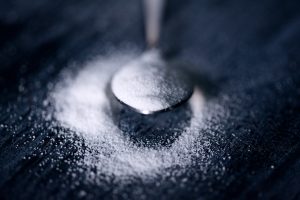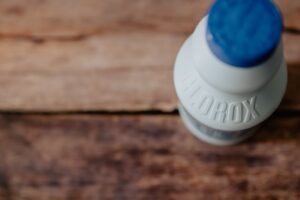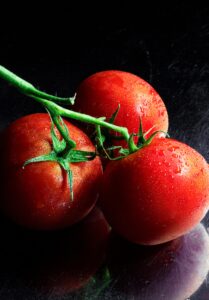
Remember this advertisement … Roses are red, violets are blue, Splenda is sweet, and so are you. Think sugar, say Splenda.
Splenda® is the trade name for sucralose. When Splenda came on the American market, it was marketed to be the white knight of sweeteners that would save everyone from the evils of aspartame.
Splenda’s intent to compete against aspartame was successful, but its popularity has been declining over the years because of its side-effects.
Canada became the first country to approve Splenda in 1991, and the US Food and Drug Administration (FDA) granted American marketing approval in 1998. Johnson & Johnson purchased the rights to sell sucralose commercially as Splenda in the United States, and put it on the market in 2000.
J&J created McNeil Specialty Products (renamed McNeil Nutritionals) as part of the Johnson & Johnson corporate umbrella for the exclusive purpose of marketing Splenda – entering the sweetener war as its newest contender.
Splenda was marketed as tasting nearly identical to sugar, and its “trademark” was its inability to break down in processing or in storage.
Things that don’t break down are red flags to me. Just saying.
Is It Safe?

So why is Splenda harmful to your health?
Splenda contains chlorine, and chlorine is a carcinogen when you ingest it. Splenda marketers insure us that the chlorine is chemically “bound” so it cannot be “released” in your body.
If you know basic chemistry, you’ll question this claim because even though chlorine is on the Periodic Table, isolated chlorine is rarely found in nature – it is commonly found as a compound.
In other words, chlorine easily combines with other elements, and the most common of these elements is salt, forming sodium chloride.
So, isolated chlorine is not a natural food source and cannot safely pass through your body. Think about it – do you drink chlorine?
When Splenda first came on the market, crafty marketers boasted, “Sucralose is made from sugar through a process that selectively substitutes three of the four hydrogen-oxygen groups on the sucrose (sugar) molecule for three atoms of chlorine.”
In other words, sucralose is 3 parts chlorine to 1 part sugar, which makes Splenda a chlorocarbon – a chlorine containing compound. Chlorocarbons have long been known for causing organ, genetic, and reproductive damage.
It should be no surprise that the lab testing of sucralose revealed organ, genetic, and reproductive damage in the laboratory animals.
The research on lab rats also showed up to forty percent shrinkage of the thymus gland: the gland that is the very foundation of your immune system.

Chlorine
It’s common to wonder why chlorine is harmful if it is used to kill germs in tap water and in swimming pools. But, there is a big difference between natural chlorine and manmade chlorine.
Chlorine readily bonds with other elements in nature to form chlorides, and some can be safely ingested, like sodium chloride. No where in Nature does chlorine combine with sugar, though.
Due to the chlorine in Splenda, sucralose can provoke swelling of your liver and kidneys, and result in the calcification of your kidneys, and this was shown in animal studies.
If you experience kidney pain, stomach cramping, or bladder infections when using sucralose, stop using it immediately.
Sucralose is patented as a manmade “chlorinated sucrose sweetener”, and it is recorded in FDA files as “chlorinated sucrose.” Again, chlorinated sucrose is not found anywhere in nature, like with real sugar (sucrose) that is found in sugar cane and sugar beets.
Natural chlorides are found in the soil, spring water, and in food, and they are relatively harmless. Your body actually uses chlorides in small amounts to cleanse your liver. But chlorocarbons, on the other hand, are a serious problem in developed countries becasue they are NOT found in Nature, and they make many people very ill.
Manmade chlorine (like what’s used to make Splenda) is essentially bleach forced to combine with sugar.
OSHA

OSHA (the Federal Occupational Safety and Hazard Association) regulates chlorine, the chemical used to make Splenda.
OSHA States:
… any animal that eats or drinks chlorine (especially on a regular basis) is at risk of cancer.
The Merck Manuel and OSHA 40 SARA 120 Hazardous Waste Handbook states:
Chlorine is a carcinogen and emergency procedures should be taken when exposed via swallowing, inhaling, or through the skin.
The safety of chlorine added to our public water supply is always being monitored because it does cause cancer. Manufactured chlorine can be an extremely toxic biohazard, and I was shocked when I first learned that chlorine was in Splenda.
Splenda manufacturers defend their chlorine safety claim by defending that the chlorine in sucralose won’t break down during digestion. But if you are healthy and have an extremely efficient digestive system, your body will try to break it down.
After all, this is what your body is supposed to do with anything that you eat.
So chances are all the ingredients in Splenda will be digested and assimilated by your body. Why take the chance?
A study by Dr. Niels Skakkebaek at the University of Copenhagen demonstrated that the average human sperm counts have dropped in Denmark by almost fifty percent due to the presence of manmade chlorine found within human tissues and breast milk.
The Splenda marketers disagree, but they are defending the chlorine in Splenda as being the same as the chlorides found naturally in food.

“People consume chlorine every day in foods like melon, tomatoes, lettuce, and mushrooms as well as prepared products such as peanut butter,” says McNeil’s Leslie Goldsmith.
NutraSweet stated the same thing about the methanol in aspartame. Methanol is found naturally in foods, but it is compounded with other elements that buffer it in Nature. The isolated, manufactured methanol found in aspartame is a different form of methanol, and it is toxic when ingested.
This brings me back to my original point that when people refer to chlorine, they don’t realize the difference between natural forms of chlorine and the laboratory version.
All chlorine is not the same.
So, eat your tomatoes and mushrooms to keep your liver clean, but avoid drinking chlorine used to disinfect your swimming pool.
_______________
If you want to learn more about healthy living and disease prevention, contact me at janethull.com. Remember that you are never alone when you are looking for good health!
I look forward to supporting you on your journey to alternative health and wellness.
_____________
Disclaimer: This article is for informational purposes only, and is educational in nature. The FDA may not have evaluated some of the statements. This article is not intended to diagnose, treat, cure, or prevent any disease. Please discuss with your own, qualified health care provider before adding supplements or making any changes to your dietary program.
Before taking vitamins, consult your doctor; pre-existing medical conditions or medications you are taking can affect how your body responds to multivitamins.
You have our permission to reprint this article if you attribute us with a live back-link to this article and the youtube links. http://www.janethull.com/
_______________